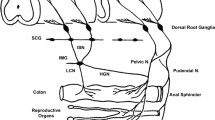Conclusion
The muscles of the pelvic floor are unique by virtue of their nervous mechanism. No other muscle will fulfill their function, which is the reason for failure of the Wredon-Stone operation for incontinence. Without constant reflex postural activity, there cannot be continence.
The electrical activity occurring in the muscles of the pelvic floor, which can be recorded by electromyographic means, has been well described by other investigators. Our efforts have been directed toward investigation of the mechanism of this activity and the means by which it can be modified. Our findings suggest that the mechanism is reflex and we propose that it be known as thepostural reflex of the pelvic floor. In addition, we have described inhibition of this reflex by rectal distention. This phenomenon is also due to a reflex arc and we suggest that it be calledthe rectal inhibitory reflex. These closely interrelated reflexes have many practical and theoretical implications, especially in relation to continence and rectal prolapse.
Similar content being viewed by others
References
Beck, A.: Elektromyographische Untersuchungen am Sphincter ani (Ein Beitrag zur Tonusfrage). Arch. ges. Physiol.254: 278, 1930.
Bishop, B., R. C. Garry, T. D. M. Roberts and J. K. Todd: Control of the external sphincter of the anus in the cat. J. Physiol.134: 229, 1956.
Denny-Brown, D. and E. G. Robertson: An investigation of the nervous control of defaecation. Brain.58: 256, 1935.
Floyd, W. F. and E. W. Walls: Electromyography of sphincter ani externus in man. J. Physiol.122: 599, 1953.
Garry, R. C.: The responses to stimulation of the caudal end of the large bowel in the cat. J. Physiol.78: 208, 1933.
Gaston, E. A.: The physiology of fecal continence. Surg., Gynec. & Obst.87: 280, 1948.
Goligher, J. C. and E. S. R. Hughes: Sensibility of the rectum and colon: Its role in the mechanism of anal continence. Lancet.1: 543, 1951.
Gowers, W. R.: The automatic action of the sphincter ani. Proc. Roy. Soc. London.26: 77, 1877.
Masius, J. P.: Recherches experimentales sur l’innervation des sphincters de l’anus et de la vessie. Bull. Acad. d. sc. de Belge, Brux.1: 491, 1868.
Porter, N. H.: In press.
Taverner, D. and F. G. Smiddy: An electromyographic study of the normal function of the external anal sphincter and pelvic diaphragm. Dis. Colon & Rectum.2: 153, 1959.
Author information
Authors and Affiliations
Additional information
Read at the meeting of the American Proctologic Society, Pittsburgh, Pennsylvania, June 21 to 24, 1961.
About this article
Cite this article
Parks, A.G., Porter, N.H. & Melzak, J. Experimental study of the reflex mechanism controlling the muscles of the pelvic floor. Dis Colon Rectum 5, 407–414 (1962). https://doi.org/10.1007/BF02616644
Issue Date:
DOI: https://doi.org/10.1007/BF02616644




